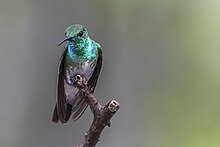Mangrove Macilia
| Mangrove Macilia | ||||||||||
|---|---|---|---|---|---|---|---|---|---|---|

Mangrove macilia (♂ above, ♀ below), depiction by Jean-Marie Fugère (1818–1882) |
||||||||||
| Systematics | ||||||||||
|
||||||||||
| Scientific name | ||||||||||
| Amazilia boucardi | ||||||||||
| ( Mulsant , 1877) |
The mangrove macilia ( Amazilia boucardi ) is a species of bird in the hummingbird family (Trochilidae). This monotypical species is endemic to the Central American country of Costa Rica . The stock is on the IUCN as endangered ( Endangered estimated).
features
The mangrove macilia reaches a body length of about 9.5 centimeters with a weight of 6.5 grams. The male is pale green both on the vertex and on the top with a bronze tint on the rump. The tail is bronze-green in color and is slightly forked. The whitish underside is marbled light green to bluish on the chest and sides. The birds have a dark beak about 18 millimeters long with a reddish lower bill. The females are very similar to the males, but the underside is mainly white with only small speckles on the throat and sides.
distribution and habitat
The representatives of this species occur exclusively in the mangroves of the Pacific coast of Costa Rica. Here you can find them from the Gulf of Nicoya to the Golfo Dulce near Puerto Jiménez .
behavior
The hummingbirds prefer to feed on tea mangroves ( Pelliciera rhizophorae ). For food intake they move in the lower and middle strata . In addition, they also fly to trees with blossoms such as Lonchocarpus , Inga , climbing plants such as Maripa nicaraguensis , epiphytes or heliconias . They also tolerate areas adjacent to the mangroves, provided that there are tea mangroves there. The males in particular behave very aggressively, but are not territorial on the flowers.
nest
The breeding season of the mangrove macilia runs from October to February. The nest has the shape of a small calyx and consists of fibers from the balsa tree , other material that has fallen from plants, and spider webs, and is decorated on the outer walls with lichen. The nest is placed in the branches of the mangroves one to four meters above the water. There is space for two eggs, which are only hatched by the female.
Endangerment and protection status
BirdLife estimates the total population of the species at 2,500 to 10,000 individuals. The construction of seawater salines and shrimp ponds and the concrete logging for the production of charcoal destroy the ecological niche of the mangroves. Other threats include illegal woodcutting, levees, road construction and air pollution (particularly from the port in Puntarenas ). The entire Pacific coast of Costa Rica is affected by the economic developments.
Surveys are carried out on the state of the mangroves, in which the disappearance of mangrove landscapes is monitored. Further investigations aim to analyze why the species does not exist in a supposedly suitable habitat. The Carara National Park is to be expanded. A campaign may be started with the help of this endemic species to make the population aware of the existing problems.
Etymology and history of research
Étienne Mulsant originally described the mangrove macilia under the scientific name Arena boucardi . Another synonym that can be found in literature is Polyerata boucardi .
The word Amazilia comes from a novella by Jean-François Marmontel , who reported on an Inca heroine named Amazili in Les Incas, Ou La Destruction De L'empire Du Pérou . The specific epithet boucardi is a dedication to the ornithologist and collector Adolphe Boucard (1839–1905), who also published on hummingbirds.
literature
- Frank Gary Stiles, Dana Gardner, Alexander Frank Skutch : A Guide to the Birds of Costa Rica . Comstock Publishing Associates, Ithaca, New York 1990, ISBN 0-8014-9600-4 .
- David A. Luther: Mangrove Hummingbird (Amazilia boucardi) . Neotropical Birds Online (Cornell Lab of Ornithology), Ithaca 2009 ( neotropical.birds.cornell.edu [accessed July 18, 2011]).
- James A. Jobling: A Dictionary of Scientific Bird Names . Oxford University Press, Oxford 1991, ISBN 0-19-854634-3 .
- Étienne Mulsant, Édouard Verreaux: Histoire naturelle des oiseaux-mouches ou colibris constituant la famille des trochilidés . In: Société Linnéenne de Lyon . tape 4 , 1877 ( biodiversitylibrary.org [accessed September 20, 2015]).
Web links
- Amazilia boucardi inthe IUCN Red List of Threatened Species 2011.1. Posted by: BirdLife International, 2009. Retrieved July 16, 2011 ..
- BirdLife International: Species Factsheet - Mangrove Hummingbird ( Amazilia boucardi ) . Retrieved July 16, 2011.
- Videos, photos and sound recordings of Mangrove Hummingbird (Polyerata boucardi) in the Internet Bird Collection
- Mangrove Macilia ( Amazilia boucardi ) at Avibase; Retrieved January 6, 2012.
- Amazilia boucardi in the Integrated Taxonomic Information System (ITIS). Retrieved January 5, 2012.
- xeno-canto: Sound recordings - Mangrove Hummingbird ( Amazilia boucardi )
